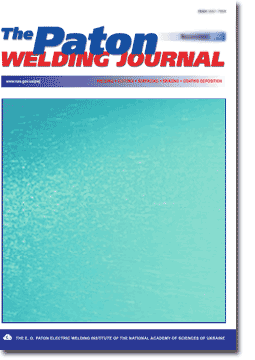

(You are viewing the simplified file contents)
AS = «Automatic Welding» - 6 issues per year;
TPWJ = «PATON WELDING JOURNAL» - 12 issues per year;
SEM = «Electrometallurgy Today» - 4 issues per year;
TDNK = «Technical Diagnostics and Non-Destructive Testing» - 4 issues per year.


| SCIENTIFIC AND TECHNICAL | |
|
Zubchenko A.S., Koloskov M.M., Amelianchik A.V., Levitan L.M. and Shirolapova T.B.
Investigation of effect of deformational treatment on residual stresses in circumferential welds. | 2 |
| The paper presents the results of investigations on optimizing technological parameters of the process of pipeline circumferential reduction to induce a pattern of compressive residual stresses in the weld zone root. The problem of lowering the residual stresses under the die is solved by optimizing the die profile along the generatrix, as well as by applying deformable gaskets between the die and pipe. | |
|
Ishchenko A.Ya., Lozovskaya A.V., Poklyatsky A.G., Sklabinskaya I.E., Mashin V.S. and Yavorskaya M.R.
Increase in strength of welds in arc welding of alloy 1420 using the Sc-containing fillers. | 10 |
| Comparative analysis of the properties of sheet welded joints of alloy 1420, produced by fusion welding with application of serial and experimental filler wires, containing scandium, is performed. It is shown that scandium addition to welding wires creates prerequisites for further strengthening of the weld metal. A heat treatment mode is suggested allowing the production of equivalent joints with an improved system of physico-mechanical properties. | |
|
Herold H., Martinek I. and Grechuk V.
Using ultrasonic welding for joining varnish-insulated wire in electric engineering applications. | 15 |
| Ultrasonic welded joints between varnish-insulated wire and mating elements of copper and its alloys CuSn6 and CuZn37 were studied. The best results were achieved with estherimide-based varnish insulation, as well as with control of welding cycle by a relative displacement of a waveguide. | |
|
Petushkov V.G., Titov V.A. and Bryzgalin A.G.
Limiting thickness of welded joints to be explosion treated. | 20 |
| Results of investigation of the efficiency of relieving residual welding stresses in joints of low-carbon steel up to 50 mm thick are given. The effect of some factors (ambient temperature, hardening modulus and strength of a material treated, and loading factor) is described. It is shown that the limiting thickness of a metal welded, that <174>senses<175> one-sided explosion treatment using detonation cords or a low-pulse explosive charge, can amount to about 50 mm. | |
| INDUSTRIAL | |
| Welding and allied technologies at the Essen Fair. | 27 |
| BRIEF INFORMATION | |
|
Pereplyotchikov E.F.
Plasma-powder cladding of internal combustion engine valves. | 42 |
| Development of surfacing materials, technology and equipment for plasma-powder cladding of internal combustion engine valves is described. | |
|
Podola N.V., Rudenko P.M. and Gavrish V.S.
Adaptive algorithm of quality control of resistance spot welding using neural networks. | 44 |
| Adaptive algorithm is suggested for quality control of the resistance spot welding of low-carbon galvanized steel taking into account the change in thickness of parts being welded. Algorithm was verified experimentally for (0.8 + 0.8), (1.2 + 1.2) and (2.0 + 2.0) mm packs. The adaptation of control algorithm from the results of spot welding of a limited number of samples provides an error in prediction of nugget diameter using a neural network of not more than 10 %. | |
|
Pismenny A.S., Polukhin V.V., Prokofiev A.S., Bondarev V.A. and Pismenny A.A.
Express-method for development and verification of pressure brazing technologies. | 47 |
| The article describes experiments on development of an express-method to determine the possibility of producing joints and performing the process of pressure brazing or braze-welding of samples of specified materials. The above method allows selection of an appropriate braze alloy, flux, activators, technological modes of pressure brazing or braze-welding without having to make the joints on full-scale samples. | |
(You are viewing the simplified file contents)
Sorry, the PDF of this issue is not yet available
The cost of subscription/purchase order journals or individual articles
| Journal/Currency | Annual Set | 1 issue printed |
1 issue |
one article |
| AS/UAH | 1800 UAH | 300 UAH | 300 UAH | 150 UAH |
| AS/USD | 192 $ | 32 $ | 26 $ | 16 $ |
| AS/EUR | 180 € | 30 € | 25 € | 15 € |
| TPWJ/UAH | 7200 UAH | 600 UAH | 600 UAH | 280 UAH |
| TPWJ/USD | 384 $ | 32 $ | 26 $ | 16 $ |
| TPWJ/EUR | 360 € | 30 € | 25 € | 15 € |
| SEM/UAH | 1200 UAH | 300 UAH | 300 UAH | 150 UAH |
| SEM/USD | 128 $ | 32 $ | 26 $ | 16 $ |
| SEM/EUR | 120 € | 30 € | 25 € | 15 € |
| TDNK/UAH | 1200 UAH | 300 UAH | 300 UAH | 150 UAH |
| TDNK/USD | 128 $ | 32 $ | 26 $ | 16 $ |
| TDNK/EUR | 120 € | 30 € | 25 € | 15 € |
AS = «Automatic Welding» - 6 issues per year;
TPWJ = «PATON WELDING JOURNAL» - 12 issues per year;
SEM = «Electrometallurgy Today» - 4 issues per year;
TDNK = «Technical Diagnostics and Non-Destructive Testing» - 4 issues per year.

